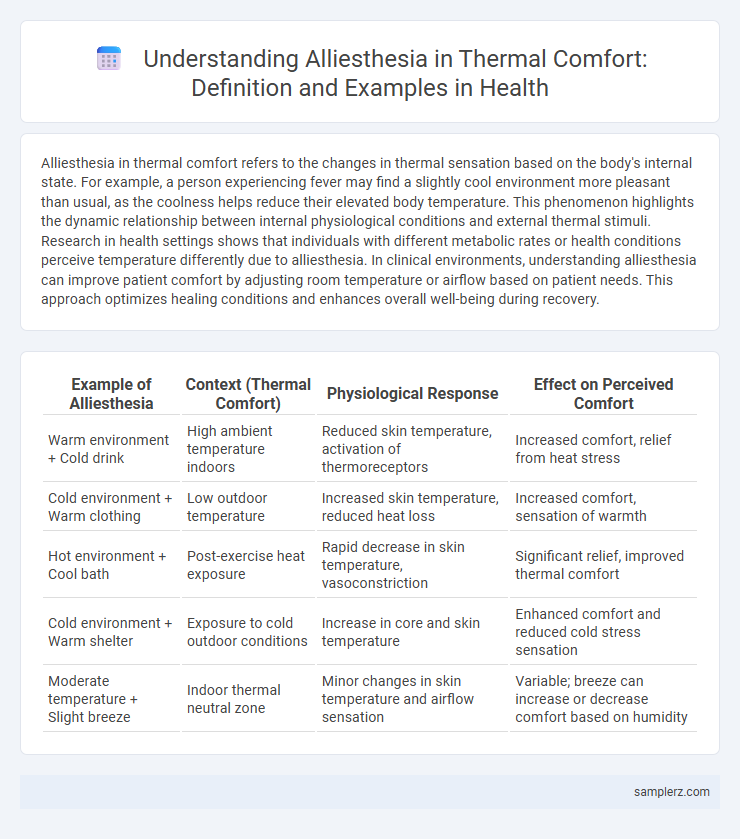Alliesthesia in thermal comfort refers to the changes in thermal sensation based on the body's internal state. For example, a person experiencing fever may find a slightly cool environment more pleasant than usual, as the coolness helps reduce their elevated body temperature. This phenomenon highlights the dynamic relationship between internal physiological conditions and external thermal stimuli. Research in health settings shows that individuals with different metabolic rates or health conditions perceive temperature differently due to alliesthesia. In clinical environments, understanding alliesthesia can improve patient comfort by adjusting room temperature or airflow based on patient needs. This approach optimizes healing conditions and enhances overall well-being during recovery.
Table of Comparison
| Example of Alliesthesia | Context (Thermal Comfort) | Physiological Response | Effect on Perceived Comfort |
|---|---|---|---|
| Warm environment + Cold drink | High ambient temperature indoors | Reduced skin temperature, activation of thermoreceptors | Increased comfort, relief from heat stress |
| Cold environment + Warm clothing | Low outdoor temperature | Increased skin temperature, reduced heat loss | Increased comfort, sensation of warmth |
| Hot environment + Cool bath | Post-exercise heat exposure | Rapid decrease in skin temperature, vasoconstriction | Significant relief, improved thermal comfort |
| Cold environment + Warm shelter | Exposure to cold outdoor conditions | Increase in core and skin temperature | Enhanced comfort and reduced cold stress sensation |
| Moderate temperature + Slight breeze | Indoor thermal neutral zone | Minor changes in skin temperature and airflow sensation | Variable; breeze can increase or decrease comfort based on humidity |
Understanding Alliesthesia in Thermal Comfort
Alliesthesia describes how thermal comfort perception changes based on the body's internal temperature state, such as feeling warm relief from a cool breeze when overheated. This phenomenon highlights the dynamic interaction between external thermal stimuli and the body's thermoregulatory system, influencing comfort preferences. Understanding alliesthesia aids in designing environments that adapt to individual thermal needs, improving health outcomes and overall well-being.
Psychological Influence on Thermal Perception
Psychological factors significantly influence thermal perception through alliesthesia, where an individual's expectation or emotional state alters their comfort response to temperature. For example, a warm room may feel more comfortable to someone anticipating cold weather, demonstrating how cognitive appraisal modulates thermal sensation. This interplay between mind and body highlights the importance of psychological context in designing environments for optimal thermal comfort.
The Role of Metabolism in Alliesthesia
Metabolism significantly influences alliesthesia by modulating the body's thermal comfort responses through internal heat production and energy expenditure. Higher metabolic rates increase heat generation, shifting the thermal comfort zone and altering sensation thresholds for warmth or cold. Understanding metabolic impacts on alliesthesia aids in designing environments that adapt to individual thermal needs for optimal health and comfort.
Seasonal Variations and Thermal Alliesthesia
Seasonal variations significantly influence thermal alliesthesia, where the perception of thermal comfort shifts depending on ambient temperature changes throughout the year. In colder months, individuals experience positive thermal alliesthesia when exposed to warmth, enhancing comfort, whereas in hotter seasons, cooling sensations are preferred to achieve thermal comfort. This adaptive response highlights the dynamic relationship between environmental temperatures and human thermal perception critical for optimizing indoor climate control and health outcomes.
Examples of Positive Alliesthesia in Warm Environments
Positive alliesthesia in warm environments occurs when warmth is perceived as pleasurable or comforting, such as enjoying a hot bath on a chilly day or basking in the sun during early spring. This thermal sensation enhances the body's thermal comfort by signaling a return to homeostasis, particularly after cold exposure. Indoor heating systems or heated clothing further demonstrate positive alliesthesia by providing localized warmth that improves overall thermal satisfaction.
Negative Alliesthesia: Overheating and Discomfort
Negative alliesthesia in thermal comfort occurs when prolonged exposure to heat leads to increased discomfort and physiological stress, such as sweating and elevated heart rate. The body's thermoregulatory responses, including vasodilation and perspiration, intensify as overheating persists, signaling a shift from neutral or positive sensations to negative ones. This phenomenon highlights the importance of maintaining optimal indoor temperatures around 20-24degC to prevent heat-induced discomfort and health risks.
Impact of Physical Activity on Thermal Sensations
Physical activity significantly influences thermal sensations by altering the body's heat production and perception, demonstrating alliesthesia in thermal comfort. Increased metabolic heat from exercise causes individuals to feel warmer even in moderate environmental temperatures, shifting their thermal preference towards cooler conditions. This physiological response highlights the dynamic interaction between physical exertion and thermal comfort regulation to maintain homeostasis.
Environmental Modifications for Optimal Thermal Comfort
Environmental modifications for optimal thermal comfort leverage alliesthesia by adjusting temperature and humidity to enhance individual thermal perception. Utilizing adaptive building technologies such as dynamic insulation, variable shading, and localized heating or cooling systems optimizes the body's thermal responses, promoting comfort and well-being. These interventions reduce thermal stress and improve occupant satisfaction by aligning environmental conditions with physiological comfort thresholds.
Individual Differences in Thermal Alliesthesia
Individual differences in thermal alliesthesia significantly influence personal thermal comfort, with factors such as age, metabolic rate, and body composition affecting the perception of temperature stimuli. For example, older adults may experience a diminished thermal alliesthetic response, leading to variations in comfort levels and vulnerability to temperature extremes. Understanding these variations is crucial for designing personalized thermal environments that enhance well-being and prevent thermal stress.
Applications of Alliesthesia in Health and Building Design
Alliesthesia describes the changing perception of thermal comfort depending on the body's internal state, influencing health outcomes and building environments. In healthcare, controlled temperature variations utilize alliesthesia to improve patient comfort and recovery by aligning thermal conditions with metabolic needs. Building design incorporates alliesthesia principles by adapting HVAC systems to occupant biothermal feedback, enhancing energy efficiency and promoting well-being.

example of alliesthesia in thermal comfort Infographic
 samplerz.com
samplerz.com